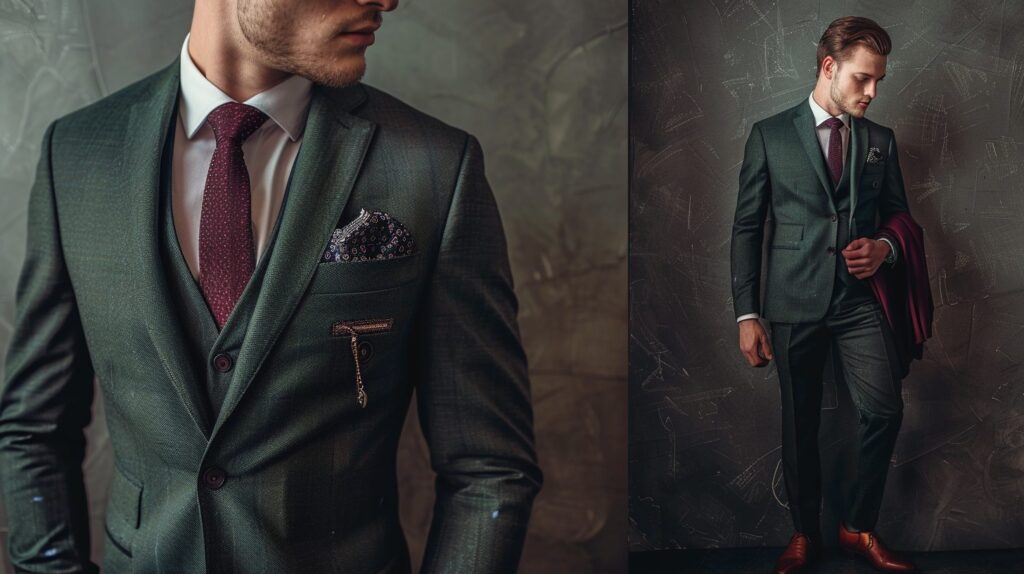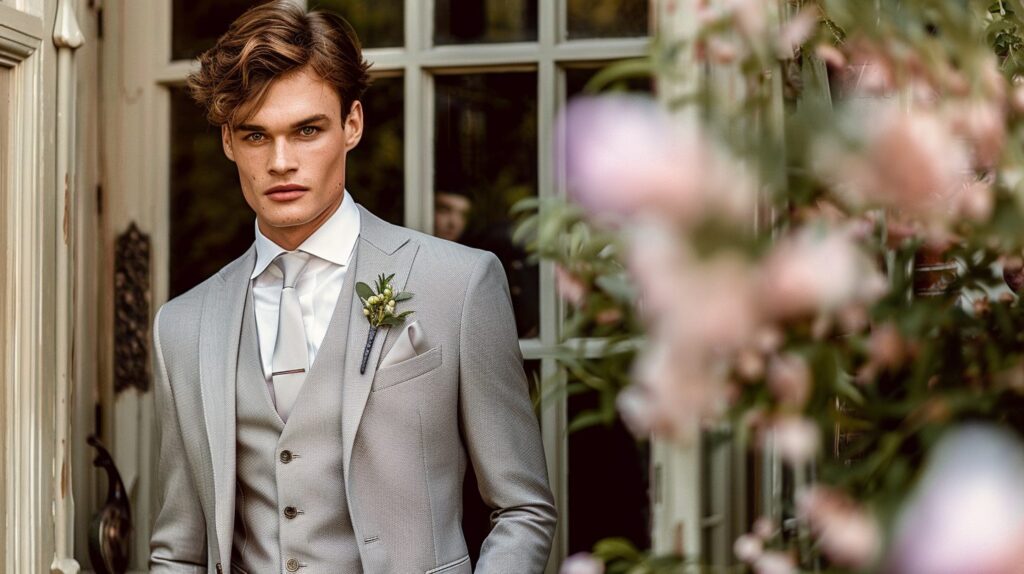You see him across the room—sharp lines, polished shoes, and an all-black suit that turns heads without saying a word.
Why does the black suit still carry so much weight in men’s style? Is it the sleek design, the association with power, or something more mysterious beneath the surface?
Whether you’re suiting up for a wedding, a business meeting, or just want to upgrade your wardrobe, understanding the meaning and style behind the black suit can help you wear it with confidence—and purpose.
In this guide, you’ll learn what a black suit says about the man wearing it, how to style it right, when to wear it, and how it evolved into a symbol of strength, elegance, and quiet authority.
Here’s what you’ll learn:
- What Makes a Suit a Suit: Understand the key parts of a suit and the differences between classic, slim, modern, and formal styles.
- The Meaning Behind the Black Suit: Discover what wearing a black suit says about style, power, and personality.
- When to Wear One (and When Not To): Learn the best times to wear a black suit—plus situations where it might not be the right choice.
- How to Style a Black Suit: Get practical tips for shirts, shoes, accessories, and layering that match different settings.
- The Evolution of the Black Suit in Culture: See how black suits have changed over time—from tradition to fashion icon.
What Is a Suit?
A suit is a matching set of clothes made from the same fabric, usually consisting of a jacket and trousers. It’s designed to give a clean, coordinated appearance and is worn for formal, business, or special occasions. Suits come in various styles, fits, and colors to suit different events, personal tastes, and body types.
Types of Suits
Slim Fit Suit
A slim fit suit hugs the body with a narrow cut through the chest, waist, and legs. It offers a sleek, modern look ideal for younger or leaner body types.
Classic Fit Suit
Classic fit suits provide extra room in the chest and legs for comfort and ease of movement. They’re great for traditional style and all-day wear in professional settings.
Modern Fit Suit
Modern fit suits blend the comfort of a classic fit with the shape of a slim fit. They offer a clean, tailored look without feeling too tight.
Single-Breasted Suit
This style features one row of buttons and a narrow overlap at the front. It’s versatile and works well for business, weddings, and social events.
Double-Breasted Suit
Double-breasted suits have two rows of buttons and a wider front panel for a bold, structured look. They’re typically more formal and often chosen for fashion-forward or upscale occasions.
Two-Piece Suit
A two-piece suit includes a jacket and matching trousers, making it a timeless and flexible choice. It’s appropriate for most business, formal, or smart-casual events.
Three-Piece Suit
The three-piece adds a matching vest to the jacket and trousers, creating a more polished and refined appearance. It’s ideal for weddings, presentations, or any event where you want extra flair.
Tuxedo
A tuxedo features satin lapels, satin-covered buttons, and often a satin stripe down the pants. It’s designed for formal evening wear and pairs best with a bow tie and patent shoes.
Patterned Suit
Patterned suits showcase designs like pinstripes, windowpane checks, or plaids for added personality. They help make a statement while staying within formal or business style lines.
Linen or Cotton Suit
These suits are made from lightweight, breathable fabrics, perfect for spring and summer. They offer a more relaxed, casual look while keeping you cool.
Styling an All-Black Suit – The Complete Guide
1. Get the Fit Perfect 📏
A black suit only works if it fits like it should. Go for a tailored or slim fit that hugs the shoulders, tapers at the waist, and breaks clean at the shoes.
2. Choose the Right Shirt 👕
- Crisp White Shirt: Classic, clean, and high contrast.
- Black Shirt: Creates a sleek, monochromatic look.
- Gray or Charcoal: Adds subtle depth without straying from the dark theme.
Stick to solid colors for a sharper look, or try a soft pattern (like microdots) if you want texture.
3. Tie or No Tie? 👔❌
- For formal events: A black silk or textured tie keeps it refined.
- For modern settings: Skip the tie and unbutton your collar for a confident, minimalist vibe.
- For weddings or galas: Consider a black bow tie for timeless elegance.
4. Footwear Matters 👞
Polished black leather shoes (like Oxfords or Derbies) keep the look classic. For evening flair, try patent leather or even velvet loafers—especially with a tux-style black suit.
5. Play With Texture and Layers 🧥
All-black doesn’t have to be boring. Use textures like matte wool, satin lapels, or a subtle pattern in the shirt or vest. In cooler weather, layer with a black overcoat or wool scarf.
6. Accessories: Less Is More ⌚🕶️
Add one or two sharp accessories:
- A black watch or silver-tone timepiece.
- A slim black belt.
- A pocket square (white for contrast, black for mystery).
Avoid loud colors—they can clash with the clean black look.
7. Grooming and Confidence 🪞
An all-black suit highlights your face, posture, and details. Keep your grooming sharp—clean shave or neat beard, styled hair, and polished nails make a huge difference.
The History and Evolution of the Black Suit in Menswear 🖤🕴️
The black suit has long been a symbol of elegance, power, and formality in menswear. Its journey from 19th-century tradition to modern-day staple reflects changing fashion, culture, and purpose.
19th Century: The Rise of Formalwear 🎩
In the early 1800s, black suits emerged as a more subdued alternative to the colorful clothing of the past. They became the uniform of respectability for upper-class men, often worn for evening events and somber occasions.
Early 20th Century: Refined and Reserved 🧥
By the 1920s and 1930s, the black suit became closely associated with formality, particularly for funerals, weddings, and formal dinners. Tailoring improved, and the black suit became more fitted and structured.
Mid-20th Century: Hollywood Glamour 🎬
Film icons like Cary Grant and Humphrey Bogart helped glamorize the black suit. It shifted from purely formal to stylish and suave, worn by leading men in both drama and romance.
1960s–1980s: Power and Rebellion ⚡
In the ’60s, mod culture and rock musicians embraced the black suit as a symbol of cool. By the ’80s, it represented power and authority in the business world—think Wall Street and executive style.
1990s–2000s: Minimalism and Versatility 🕶️
Designers began to strip the black suit back to basics—simple cuts, clean lines, and less flash. It became more versatile, worn not just at formal events but also on red carpets and in casual-chic settings.
Today: Timeless and Essential 🔁
The black suit is now a must-have in every man’s wardrobe. Whether slim-fit or classic cut, it’s worn for job interviews, black-tie events, fashion shows, or funerals—proving its enduring place in menswear.
When to Wear a Black Suit: Appropriate Occasions and Settings 🖤📅
A black suit is powerful, timeless, and sleek—but it’s not for every event. Knowing where it fits (and where it doesn’t) will help you wear it with confidence.
Best Settings ✅
Formal Events – Black suits are ideal for funerals, evening galas, or a night at the opera. They communicate formality, respect, and seriousness.
Black-Tie Optional Events – When a tuxedo isn’t required but a dressy outfit is expected, a black suit with a white shirt and dark tie is a perfect alternative.
Evening Weddings – After 5 PM, especially in colder seasons, a black suit fits right in. Just be sure to dress it up with clean accessories and polished shoes.
Court Appearances – A black suit can help convey respect, seriousness, and professionalism in legal settings. Keep the look simple and conservative.
Sometimes Avoid ⚠️
Daytime Outdoor Events – Black absorbs heat and can look too harsh under bright sunlight. Lighter suits like grey or navy are better choices for summer or garden settings.
Job Interviews in Creative Fields – In fashion, media, or design industries, a black suit might feel too stiff. A softer color like charcoal, blue, or patterned fabric shows style and approachability.
How to Style a Black Suit for Maximum Impact 🖤🔥
A black suit already commands attention—but how you style it makes all the difference. Here’s how to wear it with confidence and purpose, no matter the event.
1. Keep It Classic for Formal Events 🎩
Pair your black suit with a crisp white dress shirt, black tie or bow tie, and polished black shoes. This timeless combo is ideal for funerals, galas, or black-tie optional affairs.
2. Add Texture and Contrast for Style 🎨
Swap the plain shirt for one with subtle texture—like a light grey or patterned dress shirt. A dark tie in silk, knit, or velvet adds richness without clashing.
3. Go Tieless for a Modern Look 😎
Lose the tie and unbutton the top button for a relaxed, fashion-forward outfit. Perfect for creative events or evening parties where you still want to look sharp.
4. Play with Layers for Depth 🧥
Add a black or charcoal vest, overcoat, or turtleneck to elevate the suit. Layering gives your look more personality and seasonal versatility.
5. Mind the Fit and Finish ✂️
A black suit only looks good if it fits well—no bunching, pulling, or sagging. Keep it tailored, and make sure your shoes are clean and your shirt is wrinkle-free.
Frequently Asked Questions About Black Suits
Can a man wear a black suit to a wedding?
Yes—especially if it’s a formal or evening event. Pair it with a white shirt and slim tie for a clean look.
Is wearing a black suit to work okay?
It depends on the workplace. In corporate law or finance—yes. In tech or design—maybe not every day.
How to wear a black suit casually?
- Ditch the tie
- Use a t-shirt or knitwear instead of a dress shirt
- Wear with sneakers or boots
Can you wear a black suit to court?
Yes. It shows seriousness and respect. Keep it simple—white shirt, black tie, polished shoes.
What does a black suit represent?
- Power: Strong, commanding presence
- Style: Timeless, sleek look
- Mystery: Reserved, composed, sometimes intimidating
Is there a Man in Black 4?
This likely refers to the movie series Men in Black. “Men in Black: International” (2019) is the fourth film.
What is The Man in the Black Suit?
A short story by Stephen King about a boy who meets a mysterious man in black. It’s a mix of horror and suspense.
What is The Man in the Black Suit (2004)?
A short film adaptation of Stephen King’s story. Known for its dark, haunting tone.
What’s The Man in the Black Suit summary and analysis?
The story explores death, fear, and evil. The man in black is symbolic—possibly the Devil. It mixes childhood trauma with supernatural dread.
What does a guy in a black suit symbolize in pop culture?
Often someone with power or danger:
- Secret agents
- Mobsters
- Supernatural figures
Final Thoughts
A man in a black suit never blends in—he commands attention. Whether it’s for work, a wedding, or a funeral, black suits bring a level of seriousness and strength. They can be mysterious, stylish, or authoritative—all depending on how you wear them.


